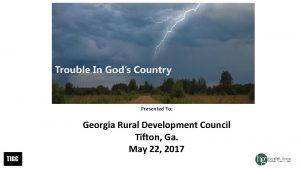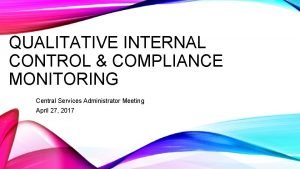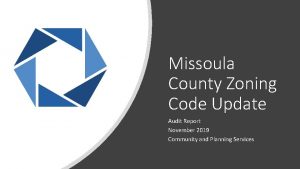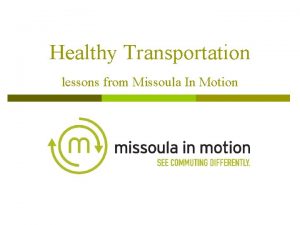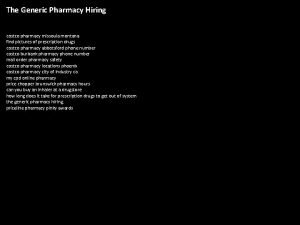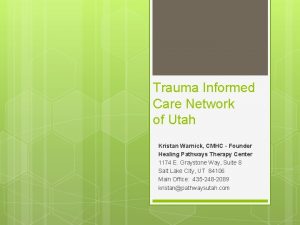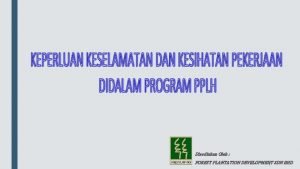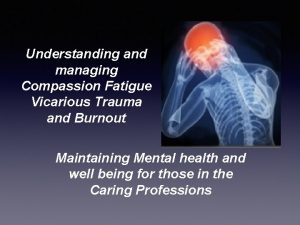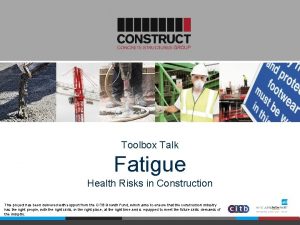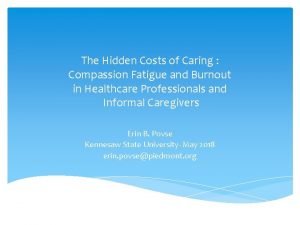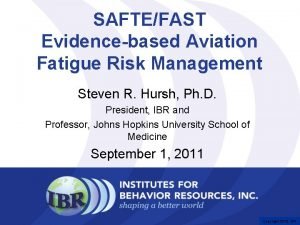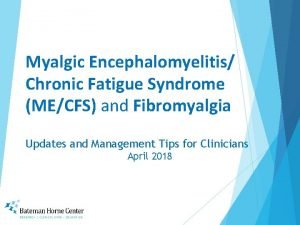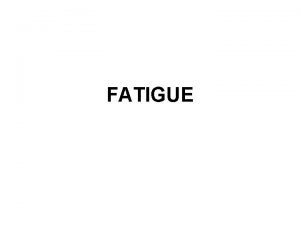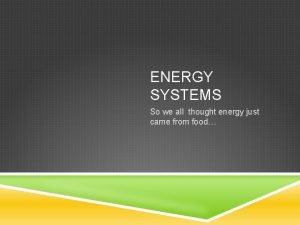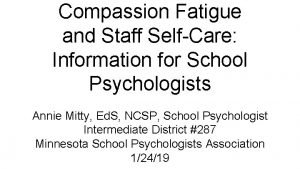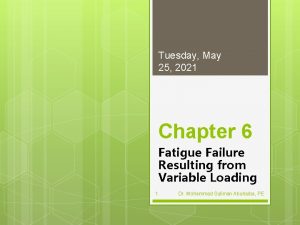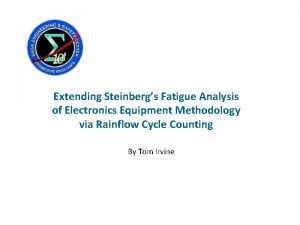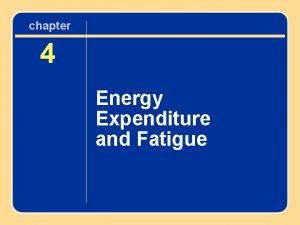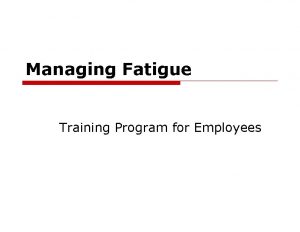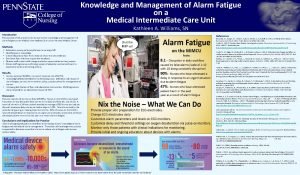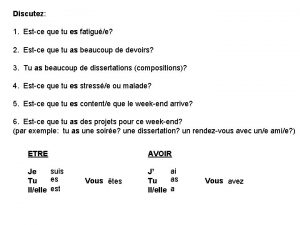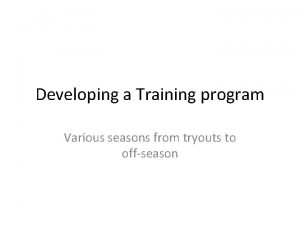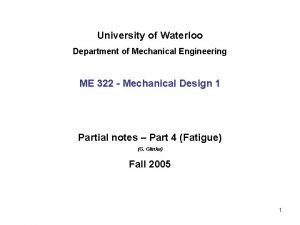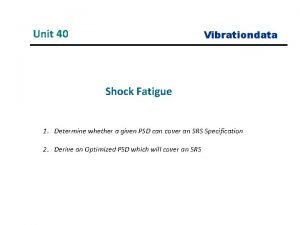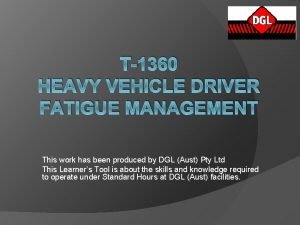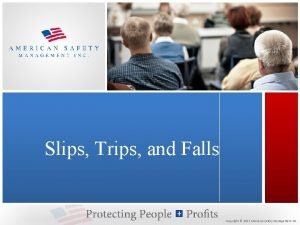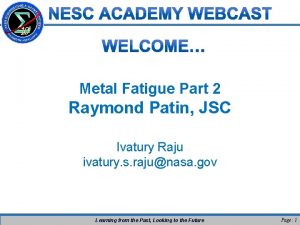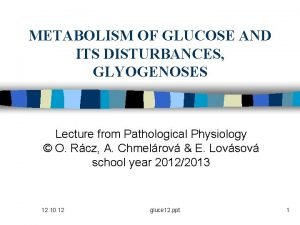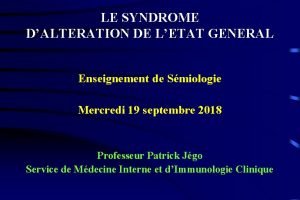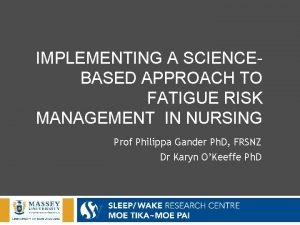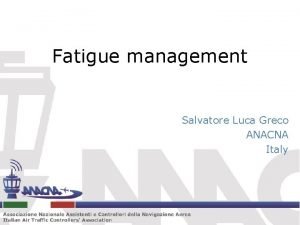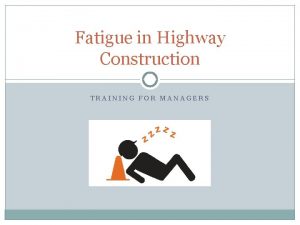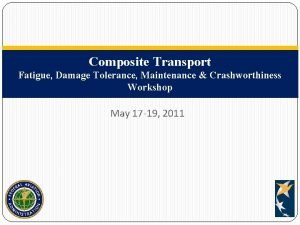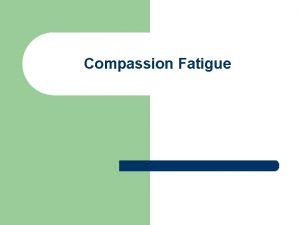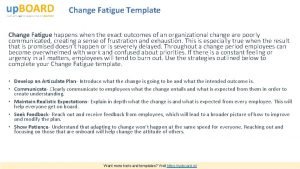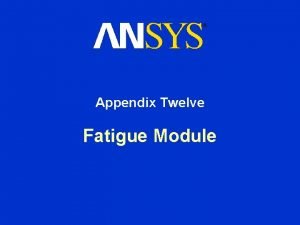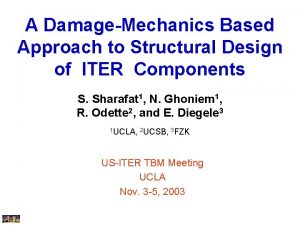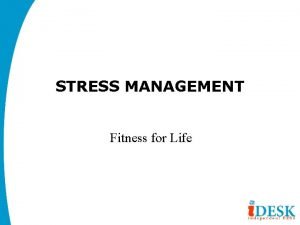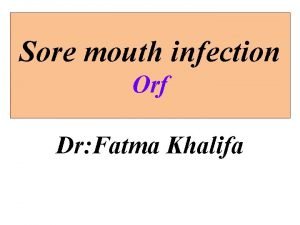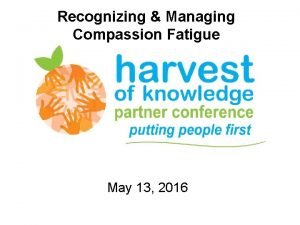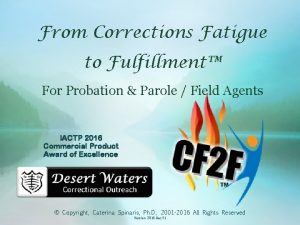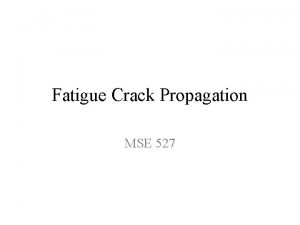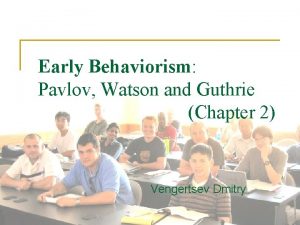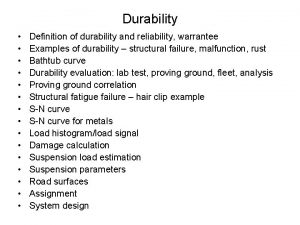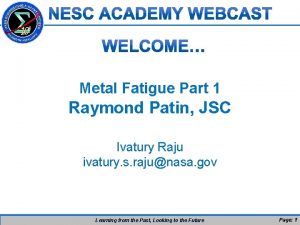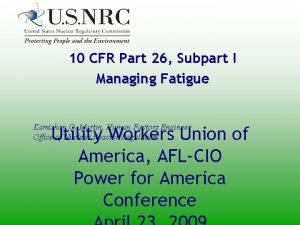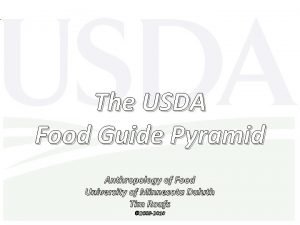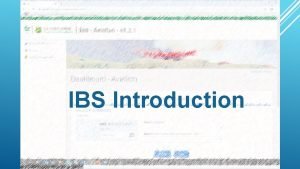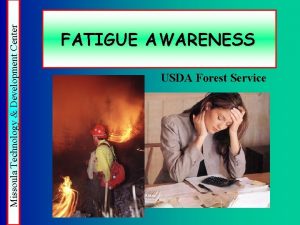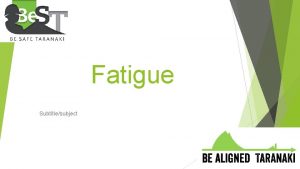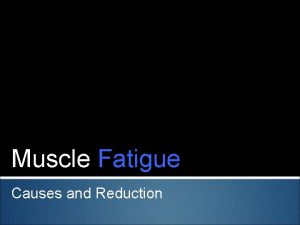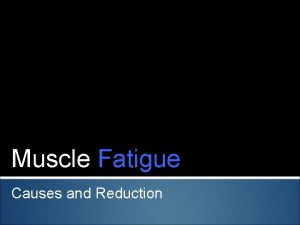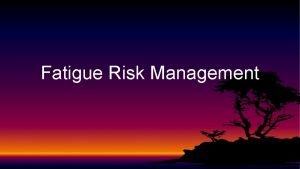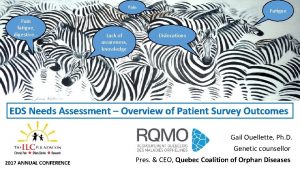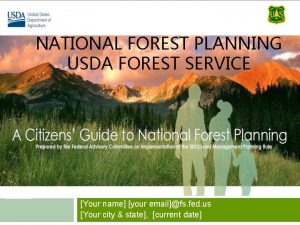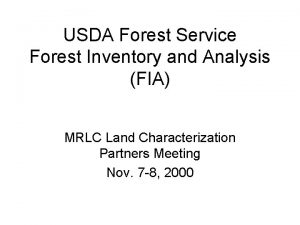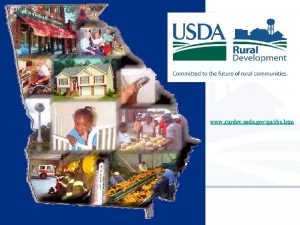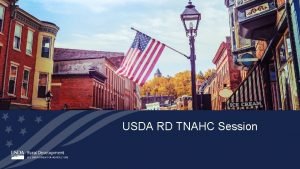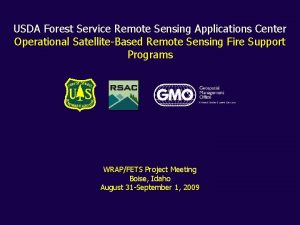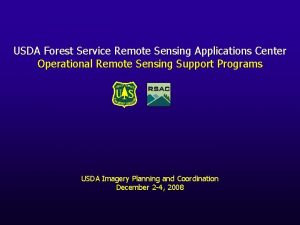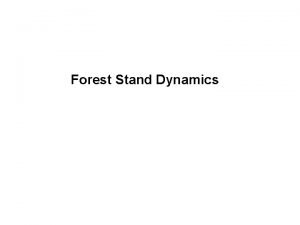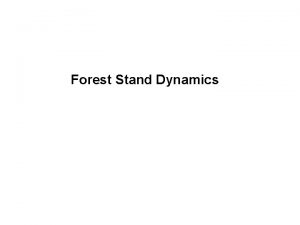Missoula Technology Development Center FATIGUE AWARENESS USDA Forest































































- Slides: 63

Missoula Technology & Development Center FATIGUE AWARENESS USDA Forest Service

Missoula Technology & Development Center Introduction v This presentation is designed to serve two groups: all agency employees, and those involved in wildland fire suppression. The material can be used for self-study or as a class presentation. Additional information concerning fatigue is listed at the end of the presentation. MTDC

Missoula Technology & Development Center Contents v Part One—All agency employees v Part Two—Fire managers, supervisors, firefighters, and support personnel v Goals are to understand: • Causes of fatigue • Factors that influence fatigue • Effects of fatigue • Signs and symptoms • Operational Strategies • Fatigue Countermeasures

Missoula Technology & Development Center Systemic Causes of Fatigue v Sleep Loss v Disruption of Circadian rhythms ØA number of biological variables exhibit a 24 -hour periodicity or rhythm. They include: wakefulness, hormones, respiratory and heart rates, blood pressure.

Missoula Technology & Development Center Types of Sleep v There are two types of sleep: ØNREM (non-rapid eye movement) and ØREM (rapid eye movement) v They alternate through the night. Both are required for quality sleep.

Missoula Technology & Development Center The Stages of Sleep

Missoula Technology & Development Center Sleep Loss v Sleep loss adds up and creates a sleep debt v Sleep loss leads to increased sleepiness v Sleep loss has consequences v Repeated loss of REM sleep can lead to neurotic behavior

Missoula Technology & Development Center Consequences v Worsening mood and communication skills v Inability to focus v Decreased mental and physical performance

Missoula Technology & Development Center Hours of Sleep v When is the last time you had eight hours of sleep? v On average everyone needs about eight hours of sleep! ØLess than 7 or more than 9 hrs of sleep is associated with poorer health (vs 7 -8 hrs sleep) v Short-term (few days) —you can get by with 6 hrs + naps

Missoula Technology & Development Center Quality vs Quantity v There a number of factors that cause disrupted sleep: ØAge—with age, sleep becomes less deep, more disrupted, and a total decrease in sleep occurs ØAlcohol and caffeine ØMedications ØEnvironment (physical & emotional) ØSleep disorders (sleep apnea)

Missoula Technology & Development Center Components of Sleep v Physiological sleepiness signals a physical need like hunger and thirst v Subjective sleepiness is how you feel ØThis can be masked by environmental stimulation, physical activity, caffeine, etc. v Estimating sleep requirements is difficult due to masking

Missoula Technology & Development Center Fatigue Accumulates

Missoula Technology & Development Center Factors that Affect Sleep v Prior sleep and wakefulness v Persons working over 16 hours on a regular shift will experience fatigue v Most persons nearing 24 hours on a continuous shift will experience cognitive impairment v Note: Regular moderate physical activity enhances the ability to fall asleep

Missoula Technology & Development Center Fatigue Awareness v Critical management decisions (stress situations) will create a sleep debt, which increases the chance that fatigue will impair your abilities v Disruption of the Circadian rhythm by working rather than sleeping between 10 p. m. and 6 a. m. increases the risk of fatigue

Missoula Technology & Development Center Sleep Deprivation v Cognitive performance: Ø Tracking task on computer Ø No change for 12 hrs Ø Drops from 12 -24 hrs Ø Rebounds 24 -29 hrs! v Conclusion: Ø Performance declines between 12 and 6 a. m. due to fatigue and Circadian rhythm. Nature 1997

Missoula Technology & Development Center Circadian Rhythms v Circadian rhythms (in brain) coordinate: üSleep/wake periods üBody temperature üHormones üDigestion üCardiovascular responses üPerformance

Missoula Technology & Development Center Fatigue Awareness v Other physiological functions: ØDisruption of the Circadian rhythm interrupts the synchronization of physiological functions, which further causes sleep loss (e. g. having to wake up in the middle of the sleep period to use the restroom)

Missoula Technology & Development Center Sleep Cycles v The Circadian rhythm has two low activity or sleep cycles: ü 2 to 5 a. m. and ü 3 to 5 p. m. v Studies show that traffic accidents caused by drivers falling asleep peak between 1 and 4 a. m. , with a smaller peak between 1 and 4 p. m.

Missoula Technology & Development Center Night Shift It takes weeks for the body to adjust to the night shift

Missoula Technology & Development Center Circadian Disruption v Changing work shifts (e. g. , night shift) and time cues (jet lag) result in: ØDisturbed sleep ØIncreased sleepiness while awake ØDegraded mental or physical condition ØWorsened mood (emotional stress) ØGastrointestinal problems

Missoula Technology & Development Center Fatigue Factors v Extended shifts or workdays can result in prolonged wakefulness, and fatigue from long or multiple shifts v Restricted time for sleep (early wake-up before 6 a. m. or beginning rest period after 10 p. m. ) results in sleep loss and cumulative sleep debt

Missoula Technology & Development Center Fatigue Factors v Night shift (10 p. m. to 6 a. m. ) or late afternoon shifts increase fatigue because of Circadian rhythm lows (2 to 5 a. m. ) and the afternoon dip (3 to 5 pm. ) v Low activity, repetitive tasks, and monitoring roles increase fatigue; passiveness creates boredom and complacency, and boredom can unmask sleepiness

Missoula Technology & Development Center Fatigue Factors v High intensity workloads (critical decision-making overload or work stress) v Increased fatigue because of the high physical or cognitive workload v Continuous workloads without breaks v Physical environment also increases fatigue: temperature, humidity, altitude, air quality, noise and vibration

Missoula Technology & Development Center Fatigue Decision-makers are more prone to the effects of fatigue than those doing hard physical work

Missoula Technology & Development Center Fatigue Factors v Heavy workload (actual or perceived) v Knowledge and use of fatigue countermeasures v Time-of-day operations v Physical environment (terrain, weather) v Vigilance requirements

Missoula Technology & Development Center Effects of Fatigue v Degraded cognitive functions (judgment, decision making) v Decreased alertness (situational awareness, perception) v Errors (missed radio calls, sloppiness, mis-understanding of orders) v Impaired concentration v Mood (complacency, irritability) v Slowed reaction times v Degraded skills

Missoula Technology & Development Center Fatigue & Immune Function v Factors that reduce immune function & open door to upper respiratory illness: ØProlonged exertion/exhaustion ØStress (hormones reduce immune function) ØInadequate energy or nutrition ØSmoke (including cigarettes) ØAlso: sleep deprivation, disruption of circadian rhythms, dehydration

Missoula Technology & Development Center Stress and Fatigue v Stress increases cortisol and epinephrine (adrenalin)—preparing the body for fight or flight v Do stress hormones erase fatigue? ØAdrenalin provides a temporary reprieve from effects of fatigue, followed by a rapid physical and emotional decline

Missoula Technology & Development Center Emergency Response v In an emergency, the effects of fatigue become critical, and may result in: ØSpatial disorientation (proximity and location of hazards, escape routes, and safety zones) ØLoss of vigilance (impairment of selfpreservation behavior and situational awareness) ØWorkload monitoring (miscalculating task requirements)

Missoula Technology & Development Center Emergency Response v Failure to consider consequences of actions (e. g. not developing a backup plan, or performing double checks) v Increased multi-tasking (splitting attention)

Missoula Technology & Development Center Fatigue Awareness Accumulated (chronic) fatigue reduces alertness, decreases productivity, and compromises immune function

Missoula Technology & Development Center Misconceptions v Many believe that being well-trained, well-motivated, professional, or having previous experience with sleep deprivation prepares them to fight off the physiological consequences of sleep loss WRONG ØPeople, especially sleepy people, can not reliably estimate their alertness and performance

Missoula Technology & Development Center Misconceptions v There is one work/rest program that prevents fatigue in everyone WRONG ØSleep cycles and Circadian rhythms are complex, and subject to individual variations. Furthermore each operation, and a multitude of factors, present different and changing sleep demands.

Missoula Technology & Development Center Fatigue Signs and Symptoms v Poor decision making v Slowed reaction time v Difficulty communicating v Forgetfulness v Fixation v Lethargy v Bad mood v About to nod off

Missoula Technology & Development Center Strategies v Alertness strategies—are preventive strategies used before or between shifts to reduce the effects of fatigue, sleep loss and circadian disruption. v Operational strategies—are used during shifts to maintain performance. However these strategies do not address the underlying physiological mechanisms, but manage the effects of fatigue. These techniques mask the underlying physiological need for sleep.

Missoula Technology & Development Center Alertness Strategies v Before the work shift, get the best possible sleep (ideally 7 to 8 hours) v Use naps appropriately (e. g. use naps before and during the shift) v Use up to two hours of naps during extended assignments. The rationale is that some sleep, even though interrupted, is better than none, and will decrease the sleep debt v Up to 20 min or 90 min naps may work best

Missoula Technology & Development Center Operational Strategies

Missoula Technology & Development Center Operational Strategies v Engage in active conversation with others (don’t just listen) v Do something physical such as stretching or moving around v Engage in light to moderate activity (e. g. , take a walk)

Missoula Technology & Development Center Operational Strategies v Caffeine consumption—requires some knowledge and experience with the effects ØUse caffeine to temporarily increase your alertness ØDo not use caffeine when already alert or before bedtime ØBe aware that it is a mild diuretic and stay hydrated v Be sensible about nutrition—eat moderate portions, don’t skip meals

Missoula Technology & Development Center Adrenalin Reprieve? v Does adrenalin from excitement or danger overcome fatigue? NO! v Adrenalin produced during the body’s fight or flight response allows a temporary reprieve—followed by a rapid and severe physical and emotional decline

Missoula Technology & Development Center Fatigue Awareness v Safety vigilance: ØAvoid sleeping near hazardous areas ØPull over and park vehicles in safe locations to take naps if feeling sleepy ØDon’t push operations or make critical decisions by yourself if you are fatigued

Missoula Technology & Development Center Fatigue Countermeasures v Improve your fitness and maintain regular physical activity v Ensure appropriate rest before assignment or work shift v Practice work cycling (hard/easy, long/short) v Adjust your work to conditions (heat and humidity)

Missoula Technology & Development Center Fatigue Countermeasures v Take rest breaks or naps (up to 20 min or 90 min) v Change tasks and tools v Take solid and liquid carbohydrate supplements to help maintain blood glucose, energy, alertness, and immune function

Missoula Technology & Development Center Conclusions v Fatigue affects everyone v Fatigue affects individuals differently v Vigilance declines—we don’t hear, see, think, or focus as well, and reactions are slowed v People are incapable of making selfdeterminations of fatigue, therefore… Leadership needs to manage fatigue!

Missoula Technology & Development Center Fatigue Awareness: Part Two

Missoula Technology & Development Center Part Two—Fire v For fire managers, supervisors, firefighters, and support personnel: ØTo understand the relationship between fatigue and long shifts, long assignments, and arduous work ØBased on evidence from studies conducted in actual working conditions

Missoula Technology & Development Center Fatigue Research v Fatigue occurs rapidly in simulated (make-work) studies v Performance is better maintained in studies of actual or meaningful work ØE. g. , even with sleep and food deprivation, fit and motivated soldiers were able to sustain performance (US Army Research Institute of Environmental Medicine, 2002)

Missoula Technology & Development Center Current Work v Fireline studies Ø Fatigue Ø Sleep Ø Energy intake Ø Energy expenditure Ø Immune function Ø Mood MTDC and the University of Montana Human Performance Laboratory

Missoula Technology & Development Center Fitness v Does fitness influence fatigue? Yes—fit workers accomplish more work with less fatigue.

Missoula Technology & Development Center Fitness and Fatigue Ruby & Gaskill 2002

Missoula Technology & Development Center Energy v Do nutrition and hydration influence fatigue? Yes—fatigue is reduced and more work is done when energy needs are met.

Missoula Technology & Development Center Supplemental Energy Blood glucose is maintained with carbohydrate supplement Energy expenditure is higher with supplement Ruby & Gaskill 2002

Missoula Technology & Development Center Shift Length v Does shift length influence fatigue? Yes—fatigue accumulates and immune function declines during long shifts.

Missoula Technology & Development Center 14 Hour Shift Recovery occurs Ruby & Gaskill 2002

Missoula Technology & Development Center 21 Hour Shift Inadequate recovery Fatigue accumulates

Missoula Technology & Development Center Work/Rest v Do rest and sleep influence fatigue? Yes—adequate rest/sleep help avoid chronic fatigue.

Missoula Technology & Development Center 2: 1 Work/Rest Ratio US Army Research Institute for the Behavioral and Social Sciences

Missoula Technology & Development Center Work/Rest Ratio v Current policy: Ø 1 hr rest for every 2 hrs work ØIdeally no more than 14 hr shift ØOver 16 hrs—must justify and document shift length, and implement countermeasures

Missoula Technology & Development Center Assignment Length v Current policy: Ø 14 day assignments ØExtensions up to 5 days—approvals are required ØBack to back assignments require approvals and 2 days rest

Missoula Technology & Development Center Conclusions v As fatigue progresses, vigilance declines —we don’t hear, see, think, or focus as well, reactions slow v Individuals and crews differ in their ability to perform during extended operations v People are incapable of making selfdeterminations of fatigue, therefore… The margin of safety needs to increase as fatigue progresses

Missoula Technology & Development Center Conclusions v The 2: 1 work/rest ratio helps to avoid accumulative fatigue (12 -14 hr shifts) v Nutrition and hydration supplements help maintain energy, cognitive function, work output, and immune function

Missoula Technology & Development Center Conclusions v Individuals and crews differ in their ability to perform during extended operations, therefore… Leadership must monitor and manage employee fatigue ØRecognize signs of fatigue ØImplement fatigue countermeasures ØMandate rest when necessary

Missoula Technology & Development Center More Information? See our web site at: http: //www. fs. fed. us/eng/t-d. php ØLook for: Wildland Firefighter Health And Safety Reports and related topics (Work Capacity, Work, Rest, Fatigue, Feeding the Wildland Firefighter, etc. )
 Missoula technology and development center
Missoula technology and development center Cvs privacy awareness training answers
Cvs privacy awareness training answers Usda mission areas
Usda mission areas Usda rural development tifton ga
Usda rural development tifton ga Compliance monitoring kalispell
Compliance monitoring kalispell Missoula county zoning
Missoula county zoning Missoula in motion
Missoula in motion Metamucil price at costco
Metamucil price at costco Lake missoula
Lake missoula Partnership dental missoula
Partnership dental missoula Trauma awareness and treatment center utah
Trauma awareness and treatment center utah Arctic domain awareness center
Arctic domain awareness center Forest plantation development sdn bhd
Forest plantation development sdn bhd Compassion fatigue signs
Compassion fatigue signs Fatigue management toolbox talk
Fatigue management toolbox talk Cost of caregiving
Cost of caregiving Saftefast
Saftefast Myalgic encephalomyelitis
Myalgic encephalomyelitis Beach marks
Beach marks What is the cause of fatigue for the alactacid system
What is the cause of fatigue for the alactacid system Compassion fatigue handout for teachers
Compassion fatigue handout for teachers Gerber equation fatigue
Gerber equation fatigue Steinberg fatigue
Steinberg fatigue Energy expenditure and fatigue
Energy expenditure and fatigue Employee fatigue training
Employee fatigue training Monitor alarm fatigue an integrative review
Monitor alarm fatigue an integrative review Es-tu fatigué
Es-tu fatigué 30m sprint fatigue test
30m sprint fatigue test Mechanical engineering design
Mechanical engineering design System shock fatigue
System shock fatigue Fatigue toolbox talk
Fatigue toolbox talk National driver work diary daily sheet
National driver work diary daily sheet Age fatigue inattentiveness eyesight and footwear are
Age fatigue inattentiveness eyesight and footwear are Composite fatigue
Composite fatigue Fatigue test
Fatigue test Muscle fatigue
Muscle fatigue Slides fatigue test
Slides fatigue test Aeg stade oms
Aeg stade oms Fatigue
Fatigue Fatigue
Fatigue Fatigue risk assessment matrix
Fatigue risk assessment matrix Icao doc 9966
Icao doc 9966 On-site manager fatigue workshop
On-site manager fatigue workshop Many fears are born of fatigue and loneliness
Many fears are born of fatigue and loneliness Crashworthiness course
Crashworthiness course Abs fatigue
Abs fatigue Vulnerability fatigue
Vulnerability fatigue Fatigue template
Fatigue template Fatigue tool ansys
Fatigue tool ansys Thermo-mechanical fatigue
Thermo-mechanical fatigue Adrenal fatigue symptoms
Adrenal fatigue symptoms Defination of fatigue
Defination of fatigue Compassion fatigue definition
Compassion fatigue definition Corrections fatigue
Corrections fatigue Fatigue crack
Fatigue crack Pavlov watson
Pavlov watson Sample of durability
Sample of durability Fatigue
Fatigue Cfr 26 subpart i
Cfr 26 subpart i Ag learn
Ag learn Paycheck8 usda
Paycheck8 usda Diet pyramid
Diet pyramid Usdalinc
Usdalinc Googla chrome
Googla chrome



